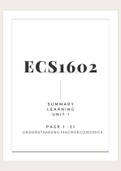ECS1602
SUMMARY
LEARNING
UNIT 1
PAGE 1 -21
UNDERSTANDING MACROECONOMICS
, CHAPTER 1
1.1 WHAT ECONOMICS IS ALL ABOUT
Economics is derived from the Greek words “oikos” (house) & “nemein” (manage)
Economics is the science of household management
ALFRED MARSHALL
A British economist from the 19th & 20th centuries, described economics as the following:
“THE STUDY OF MANKIND IN THE ORDINARY BUSINESS OF LIFE.”
THE ESSENCE OF ECONOMICS
·People have unlimited wants & needs, while the means available to satisfy them are limited
·This brings us to the scarcity problem, which requires choices to be made
·When we make a choice, we sacrifice something else – this sacrifice is called opportunity
cost
·The opportunity cost of a choice is the value to the decision-maker of the best alternative
that could have been chosen
·When we make a choice, opportunity cost is incurred
·The opportunity cost is measured in terms of determining how it could have been used
alternatively, not necessarily what it cost to purchase
Scarcity is the basic fact of economic life;
Opportunity cost is the essence of the economic way of thinking.
DEFINITION
Economics seeks to describe, explain, analyze & predict a variety of phenomena such as growth,
unemployment, inflation, trade, the prices of different goods & services, money, interest rates,
and business cycles. Each one of these topics involves a variety of choices. Since resources are
limited, choices have to be made, and opportunity cost is incurred every time a choice is made.
, 1.2 MICROECONOMICS AND MACROECONOMICS
MICRO- ECONOMICS
FOCUS ON INDIVIDUAL PARTS OF THE ECONOMY
Decisions & functioning of decision-makers is considered in isolation
from the rest of the economy & individual elements of the economy is
examined in micro-detail
Micro-economics study decisions of the following:
Individual consumers, Households, Firms, or Other organizations
Individual households decisions about what to do & what to buy
Individual firms of what goods to produce, how to produce them &
what prices to charge
It includes the study of demand, supply & prices of individual goods
and services such as petrol, maize, haircuts, and medical services
EXAMPLES FROM BOX 1.1- MICRO- ECONOMICS
The price of a single product
Changes in the price of products, such as meat
The production of wheat
The decisions of individual customers
The decisions of individual firms/businesses such as a shop or factory
The market for individual goods, such as bread
The demand for a product such as shoes
An individual decision whether to work or not
A firms decision whether to expand production, of say, motorcars
A firms decision whether to export its product
A firms decision whether to import a product
, 1.2 MICROECONOMICS AND MACROECONOMICS
MACRO- ECONOMICS
CONCERNED WITH THE ECONOMY AS A WHOLE
Overall view of the economic system and study the total (or aggregate)
economic behavior
Macro-economics study decisions of the following:
Looks at the big picture & emphasis is on topics such as:
Total Production,
Income & expenditure,
Economic growth,
Aggregate employment and unemployment,
General price level, Inflation,
The balance of payments
EXAMPLES FROM BOX 1.1- MACRO-ECONOMICS
The consumer price index
Inflation, the increase in the general level of prices in the country
Total output of all products and services in the economy
The combined outcome of the decisions of all consumers in the
country
The combined decisions of all firms in South-Africa
The market for all goods and services in the economy
The total demand for all goods and services
The total supply of all labour
Changes in total supply of goods and services
The total exports of goods & services to other countries
The total imports of goods & services from other countries
Microeconomics studies the operation of the economy at the
level where fundamental decisions are taken. In contrast,
macroeconomics focuses on aggregate economic behavior
and the aggregate performance of the economy. These can
overlap. What happens in the individual level affects the
overall performance of the economy & vice versa





